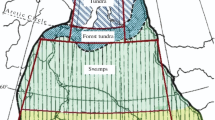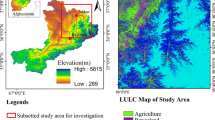Abstract
A fuzzy logic and neural network approaches are proposed to generate a cloud mask for Meteosat Second Generation Spinning Enhanced Visible and Infrared Imager (MSG SEVIRI) images. MSG images are classified into land/sea clear sky or cloudy. A spatial and temporal properties of three solar channels (0.6, 0.8 and 1.6 \(\upmu \)m), and three thermal infrared channels (3.9, 6.2 and 10.8 \(\upmu \)m) are used for this aim. The proposed methods were tested and evaluated using seventy-two MSG images taken at different times and dates. The fuzzy logic method leads to cloud detection accuracy of 84.41%, and the neural network achieved an average accuracy of 99.69%. Our proposed methods detected not only thick clouds but also thin and the less bright clouds. To give more support to our results, we made a comparison between the proposed approaches and the cloud mask product which is one of the applications integrate into software package Satellite Application Facility to NoWCasting and Very Short Range Forecasting (SAFNWC/MSG) by the European Organisation for the Exploitation of Meteorological Satellites EUMETSAT applied on the same MSG data. The high average accuracy achieved by our neural network proposed method (and more less for fuzzy logic) demonstrates its effectiveness and robustness and also the utility to benefit of using the artificial intelligent techniques in remote sensing imagery applications.





Similar content being viewed by others
References
Souza-Echer, M.P., Pereir-A, E.B., Bins, L.S., Andrade, M.A.R.: A simple method for the assessment of the cloud cover state in high-latitude regions by a ground-based digital camera. J. Atmos. Ocean. Technol. 23(3), 437–447 (2006)
Gordon, B.D., David, J.G., Sullivan, G.D.: Automatic estimation of cloud amount using computer vision. J. Atmos. Ocean. Technol. 9(1), 81–85 (1992)
Liu, Y., Xia, J., Shi, C.X., Hong, Y.: An improved cloud classification algorithm for China’s FY-2C multi-channel images using artificial neural network. Sensors 9(7), 5558–5579 (2009)
Ghosh, A., Pal, N.R., Das, J.: A fuzzy rule based approach to cloud cover estimation. Remote Sens. Environ. 100(4), 531–549 (2006)
Schmetz, J., Pili, P., Tjemkes, S., Just, D., Kerkann, J., Rota, S., Ratier, A.: An introduction to Meteosat second generation (MSG). Bull. Am. Meteorol. Soc. 83(7), 977–992 (2002)
Taravat, A., Proud, S., Peronaci, S., Del Frate, F., Oppelt, N.: Multilayer perceptron neural networks model for meteosat second generation SEVIRI daytime cloud masking. Remote Sens. 7(2), 1529–1539 (2015)
Taravat, A., Peronaci, S., Sist, M., Del Frate, F., Oppelt, N.: The combination of band rationing techniques and neural networks algorithms for MSG SEVIRI and Landsat ETM+ cloud masking. In: Geoscience and Remote Sensing Symposium (IGARSS), pp. 2315–2318. IEEE (2015)
Saunders, R.W., Kriebel, K.T.: An improved method for detecting clear sky and cloudy radiances from AVHRR data. Int. J. Remote Sens. 9(1), 123–150 (1988)
Derrien, M., Le Gléau, H.: MSG/SEVIRI cloud mask and type from SAFNWC. Int. J. Remote Sens. 26(21), 4707–4732 (2005)
Bley, S., Deneke, H.: A threshold-based cloud mask for the high-resolution visible channel of Meteosat second generation SEVIRI. Atmos. Meas. Tech. 6(10), 2713–2723 (2013)
Seze, G., Debois, M.: Cloud cover analysis from satellite imagery using spatial and temporal characteristics of the data. J. Clim. Appl. Meteorol. 26(2), 287–303 (1987)
Amato, U., Antoniadis, A., Cuomo, V., Cutillo, L., Franzese, M., Murino, L., Serio, C.: Statistical cloud detection from SEVIRI multispectral images. Remote Sens. Environ. 112(3), 750–766 (2008)
Asmala, A., Shaun, Q.: Cloud masking for remotely sensed data using spectral and principal components analysis. ETASR Eng. Technol. Appl. Sci. Res. 2(3), 221–225 (2012)
Tapakis, R., Charalambides, A.G.: Equipment and methodologies for cloud detection and classification: a review. Sol. Energy 95, 392–430 (2013)
Key, J.R., Maslanik, J.A., Barry, R.G.: Cloud classification from satellite data using a fuzzy sets algorithm: a polar example. Int. J. Remote Sens. 10(12), 1823–1842 (1989)
Tovinkere, V.R., Penaloza, M., Logar, A., Lee, J., Weger, R.C., Berendes, T.A., Welch, R.M.: An intercomparison of artificial intelligence approaches for polar scene identification. J. Geophys. Res. 98(D3), 5001–5016 (1993)
Simpson, J.J., Keller, R.H.: An improved fuzzy logic segmentation of sea ice, clouds, and ocean in remotely sensed arctic imagery. Remote Sens. Environ. 54(3), 290–312 (1995)
Baum, B.A., Tovinkere, V., Titlow, J., Welch, R.M.: Automated cloud classification of global AVHRR data using a fuzzy logic approach. J. Appl. Meteorol. 36(11), 1519–1540 (1997)
Lee, J., Weger, R.C., Sengupta, S.K., Welch, R.M.: A neural network approach to cloud classification. IEEE Trans. Geosci. Remote Sens. 28(5), 846–855 (1990)
Ackerman, S.A., Strabala, K.I., Menzel, W.P., Frey, R.A., Moeller, C.C., Gumley, L.E.: Discriminating clear sky from clouds with MODIS. J. Geophys. Res. 103(D24), 32–141 (1998)
Platnick, S., King, M.D., Ackerman, S.A., Menzel, W.P., Baum, B.A., Riédi, J.C., Frey, R.A.: The MODIS cloud products: algorithms and examples from Terra. IEEE Trans. Geosci. Remote Sens. 41(2), 459–473 (2003)
Zhu, Z., Woodcock, C.E.: Object-based cloud and cloud shadow detection in Landsat imagery. Remote Sens. Environ. 118, 83–94 (2012)
Hocking, J., Francis, P.N., Saunders, R.: Cloud detection in Meteosat Second Generation imagery at the Met Office. Meteorol. Appl. 18(3), 307–323 (2011)
Simpson, J.J., Jin, Z., Stitt, J.R.: Cloud shadow detection under arbitrary viewing and illumination conditions. IEEE Trans. Geosci. Remote Sens. 38(2), 972–976 (2000)
ftp://iacftp.ethz.ch/pub_read/giuntai/SAF-NWC-CDOP-INM-SW-SUM-2_v6.0.pdf
Nair, M.S., Lakshmanan, R., Wilscy, M., Tatavarti, R.: Fuzzy logic-based automatic contrast enhancement of satellite images of ocean. SIViP 5(1), 69–80 (2011)
Bose, A., Mali, K.: Fuzzy-based artificial bee colony optimization for gray image segmentation. Signal Image Video Proc. 10(6), 1089–1096 (2016)
Gharieb, R.R., Gendy, G., Abdelfattah, A.: C-means clustering fuzzified by two membership relative entropy functions approach incorporating local data information for noisy image segmentation. SIViP 11(3), 541–548 (2017)
Kumar, Y., Dewal, M.L., Anand, R.S.: Epileptic seizures detection in EEG using DWT-based ApEn and artificial neural network. SIViP 8(7), 1323–1334 (2014)
Lensky, I.M., Rosenfeld, D.: Clouds-aerosols-precipitation satellite analysis tool (CAPSAT). Atmos. Chem. Phys. 8(22), 6739–6753 (2008)
Reuter, M., Thomas, W., Albert, P., Lockhoff, M., Weber, R., Karlsson, K.G., Fischer, J.: The CM-SAF and FUB cloud detection schemes for SEVIRI: validation with synoptic data and initial comparison with MODIS and CALIPSO. J. Appl. Meteorol. Climatol. 48(2), 301–316 (2009)
Karlsson, K.G., Dybbroe, A.: Evaluation of arctic cloud products from the EUMETSAT climate monitoring satellite application facility based on CALIPSO-CALIOP observations. Atmos. Chem. Phys. 10(4), 1789–1807 (2010)
Jang, J.D., Viau, A.A., Anctil, F., Bartholomé, E.: Neural network application for cloud detection in SPOT VEGETATION images. Int. J. Remote Sens. 27(4), 719–736 (2006)
Acknowledgements
Authors would also like to thank: The European Organisation for the Exploration of Meteorological Satellites EUMETSAT for providing all the MSG SEVIRI used in this work. The State Meteorological Agency AEMET SPAIN to give us access to the SAFNWC/MSG software.
Author information
Authors and Affiliations
Corresponding author
Rights and permissions
About this article
Cite this article
Reguiegue, M., Chouireb, F. Automatic day time cloud detection over land and sea from MSG SEVIRI images using three features and two artificial intelligence approaches. SIViP 12, 189–196 (2018). https://doi.org/10.1007/s11760-017-1145-0
Received:
Revised:
Accepted:
Published:
Issue Date:
DOI: https://doi.org/10.1007/s11760-017-1145-0




